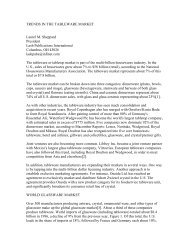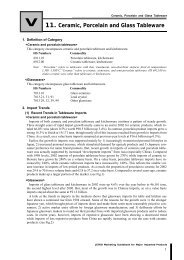Appendices to CBI Export Planner - crecer
Appendices to CBI Export Planner - crecer
Appendices to CBI Export Planner - crecer
You also want an ePaper? Increase the reach of your titles
YUMPU automatically turns print PDFs into web optimized ePapers that Google loves.
<strong>CBI</strong> <strong>Export</strong> <strong>Planner</strong>In its publication ‘<strong>Export</strong>ing <strong>to</strong> the European Union’ <strong>CBI</strong> has summed up all regulationsgoverning standardisation and health and safety protection.The third category is the one that requires you <strong>to</strong> mark your product with the famous‘CE’ when that product is potentially hazardous. In order <strong>to</strong> be allowed in<strong>to</strong> circulationfor trade in the European Single Market, some products have <strong>to</strong> answer <strong>to</strong> certainregulations that ensure the health and safety protection of European citizens and theirenvironment. The HACCP rules for foodstuff preparation are a good example. In mos<strong>to</strong>ther industrialized markets you will find similar regulations. You should check first,before considering importing in<strong>to</strong> such markets.To inform you on important environmental aspects <strong>CBI</strong> has set up a computerized‘GreenBuss ® ’ database and has prepared the ‘Eco Trade Manual’ <strong>to</strong>gether withEnvironmental Quick Scans for specific product groups.Other non-tariff barriers concern the imports of endangered animals, birds and plants(CITES), or products which serve military purposes.All those import restrictions or privileges can be checked out easily. Your government,your embassies, your Chambers of Commerce, your Trade Promotion Organizations, orthe representative of the EU will be able <strong>to</strong> inform you adequately.The last category is of an informal nature and comes from ‘grassroot’ origins.Occasionally, consumers or citizens in general form pressure groups - sometimes evendemonstrating on the streets - <strong>to</strong> force government <strong>to</strong> put an end <strong>to</strong> business practicesthey find unethical or anti-social. They may protest against feeding the babies with infantformula, not with mothers’ milk. They may protest against child labour and inviteeverybody <strong>to</strong> s<strong>to</strong>p buying products which are made by minors. They may protest againstfood preservation by gamma-radiation, or against genetically manipulated foodstuffs orbiotechnology. Eventually, such consumeristic movements succeed in setting governmentrules; the ILO did it, the SA 8000 (Social Accountability) are examples of such. Moreoften than not, the fact that consumers do not like certain practices, compels suppliers <strong>to</strong>adopt new manufacturing processes or materials.Figure 3.1.4Import and freecirculation rulesFormalImport and free circulation rulesInformalTariff Non-tariff Consumeristic protestDuties, accises,quotas, preferencesStandardization,safety & healthprotectionProtests against child labour,biotechnology, geneticmanipulation, pollutingproduct components etc.But always and even for products or services that are not regulated in the abovementioned manner, the main ‘import barrier’ will be the current market situation, ormore explicitly, the space that is left over for you by the present competitive suppliers.This is not a technical import barrier, but it can prove <strong>to</strong> be a commercial one. You canuse that knowledge <strong>to</strong> your own benefit.34 III - The export marketing mix





